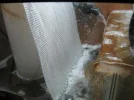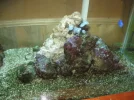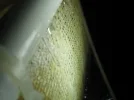SantaMonica
Reefing newb
Final screen version
The previous screen material that I had people testing was starting to rip where the tie-wraps went through, so it was not working. I did find a custom manufactured solution to solve this, which used a solid sheet on the inside of the screen, but it was just too much money. So it looks like the best screen material for me to offer is extreme-roughened, double-layered, plastic canvas.
As you know, if you already tried to rough up plastic canvas, all the work is in making it rough. You have to use a hole-saw (by hand), since sandpaper does not leave the "jagged" pieces that you want. You really need the jagged pieces which will grab hold of the algae, so the algae won't let go and fall into the water. This is of course because more algae growth (i.e, more filtering) means more weight. You DO want lots of algae (weight), but you DON'T want it to fall off of the screen. It should look like this:




Since the prickly catcus-like parts don't show well on the camera, I did a towell-drop test on the canvas. Here is the roughed-up version:
http://www.radio-media.com/fish/CanvasTowellDrop1.mpg
Versus the smooth version:
http://www.radio-media.com/fish/CanvasTowellDrop2.mpg
And both sides of both layers needs to be rough, so that algae will stay on the inside (between the layers) of the screen after you clean the outsides. And since the algae stays on the inside of the screen, you can clean the outside as hard as you want (scrape all the algae off) without worrying about "keeping some algae on the the screen".
So since this material has already been proven by hundreds of people who are using it right now (athough I never see it roughed up enough), it is just a matter of how much money is fair for a completed screen. If there is enough interest, then I'll start selling them.
It looks like I can make them for 20 cents per square inch. This is equal to:
0.20 USD per square inch
.032 USD per square cm
2.65 MXN per square inch
0.43 MXN per square cm
0.22 CAD per square inch
.035 CAD per square cm
0.14 EUR per square inch
.023 EUR per square cm
0.12 GBP per square inch
0.02 GBP per square cm
0.28 NZD per square inch
0.45 NZD per square cm
0.28 SGD per square inch
.045 SGD per square cm
1.49 ZAR per square inch
.024 ZAR per square cm
1.31 FRF per square inch
0.21 FRF per square cm
2.20 NLG per square inch
0.35 NLG per square cm
70.0 PHP per square inch
11.2 PHP per square cm
Shipping would be extra of course. Also, the screen area is just the finished screen size; you don't have to think about the multiple layers. So as an example:
A 10 X 10 inch screen = 100 square inches = $20 USD = $265 MXN = $22 CAD etc.
A 40 X 60 cm screen = 2400 square cm = $76.80 USD = $1032 MXN = $84 CAD etc.
A 3 X 6 inch nano screen = 18 square inches = $3.60 USD = $48 MSN = $3.96 CAD etc.
So post on here if you would get one at this price. There needs to be enough people otherwise it is not worth setting up to do it. If there is enough interest (at this price), then I will make them.
The previous screen material that I had people testing was starting to rip where the tie-wraps went through, so it was not working. I did find a custom manufactured solution to solve this, which used a solid sheet on the inside of the screen, but it was just too much money. So it looks like the best screen material for me to offer is extreme-roughened, double-layered, plastic canvas.
As you know, if you already tried to rough up plastic canvas, all the work is in making it rough. You have to use a hole-saw (by hand), since sandpaper does not leave the "jagged" pieces that you want. You really need the jagged pieces which will grab hold of the algae, so the algae won't let go and fall into the water. This is of course because more algae growth (i.e, more filtering) means more weight. You DO want lots of algae (weight), but you DON'T want it to fall off of the screen. It should look like this:




Since the prickly catcus-like parts don't show well on the camera, I did a towell-drop test on the canvas. Here is the roughed-up version:
http://www.radio-media.com/fish/CanvasTowellDrop1.mpg
Versus the smooth version:
http://www.radio-media.com/fish/CanvasTowellDrop2.mpg
And both sides of both layers needs to be rough, so that algae will stay on the inside (between the layers) of the screen after you clean the outsides. And since the algae stays on the inside of the screen, you can clean the outside as hard as you want (scrape all the algae off) without worrying about "keeping some algae on the the screen".
So since this material has already been proven by hundreds of people who are using it right now (athough I never see it roughed up enough), it is just a matter of how much money is fair for a completed screen. If there is enough interest, then I'll start selling them.
It looks like I can make them for 20 cents per square inch. This is equal to:
0.20 USD per square inch
.032 USD per square cm
2.65 MXN per square inch
0.43 MXN per square cm
0.22 CAD per square inch
.035 CAD per square cm
0.14 EUR per square inch
.023 EUR per square cm
0.12 GBP per square inch
0.02 GBP per square cm
0.28 NZD per square inch
0.45 NZD per square cm
0.28 SGD per square inch
.045 SGD per square cm
1.49 ZAR per square inch
.024 ZAR per square cm
1.31 FRF per square inch
0.21 FRF per square cm
2.20 NLG per square inch
0.35 NLG per square cm
70.0 PHP per square inch
11.2 PHP per square cm
Shipping would be extra of course. Also, the screen area is just the finished screen size; you don't have to think about the multiple layers. So as an example:
A 10 X 10 inch screen = 100 square inches = $20 USD = $265 MXN = $22 CAD etc.
A 40 X 60 cm screen = 2400 square cm = $76.80 USD = $1032 MXN = $84 CAD etc.
A 3 X 6 inch nano screen = 18 square inches = $3.60 USD = $48 MSN = $3.96 CAD etc.
So post on here if you would get one at this price. There needs to be enough people otherwise it is not worth setting up to do it. If there is enough interest (at this price), then I will make them.










